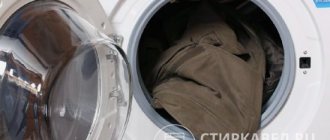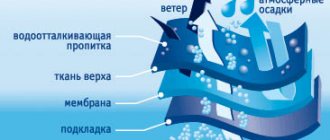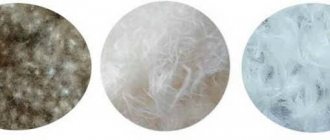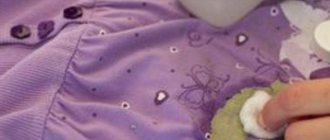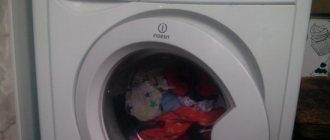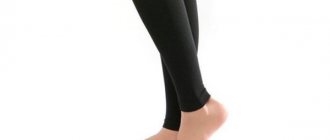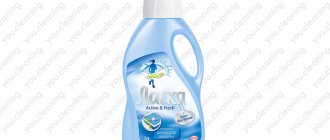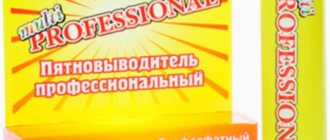Home » Home » Table with decoding of signs on clothing labels for washing
In order to extend the life of your favorite silk blouse or cashmere sweater, it is not enough to use expensive washing powder or softening conditioner.
To ensure that clothes do not lose their appearance after washing, you need to know exactly what care conditions are optimal for each specific material.
Manufacturers place this information in abbreviated form on the labels. To find out how to wash and iron correctly, whether it is possible to use bleach and high spin speeds, you need to take the time and carefully look at the signs drawn there.
And in order for these pictures to stop looking like incomprehensible encryption, you just need to remember the table of symbols used by all clothing manufacturers.
Wash
Designation and interpretation of washing icons:
- Basin with a wave - washing and soaking allowed.
- The numbers 40, 60, 95 indicate the maximum temperatures in °C that can be used to wash the product. At 95 °C the fabric can be boiled.
- One parallel line under the basin - gentle washing is indicated. Do not push at high speeds.
- Two parallel lines under the basin - delicate wash required. When using a machine wash, fill the drum no more than a third full. Set to delicate mode and do not wring out.
- Hand immersed in the basin - hand wash only at a temperature not exceeding +40 °C with hand spin. Suitable for silk, guipure or satin items.
- Schematic representation of a washing machine, enclosed in a circle - machine washing is prohibited. Typically, such signs designate clothes decorated with a large number of beads, sequins and rhinestones.
- A crossed out basin cannot be washed at home. This applies to outerwear - jackets or coats that require professional dry cleaning.
What does he look like?
An icon prohibiting washing an item in an automatic or semi-automatic washing machine is depicted by the manufacturer on labels in cases where the item of clothing can only be washed by hand, or if it can only be dry cleaned. In the first case, our icon complements the familiar sign, which is a drawing of a basin with water and a hand lowered into it - “hand wash”, and in the second case, a basin with water crossed out crosswise - “washing is prohibited”.
If the item can still be washed by hand, then the manufacturer is being disingenuous by categorically prohibiting machine washing, because modern automatic washing machines have a special “Hand Wash” mode. Having this mode, you don’t have to wash it by hand, the machine will do everything for you, and such a procedure will not cause any harm to the item.
In the picture above you can see a close-up of a sign prohibiting washing an item of clothing in a washing machine. This image, it should be noted, is very spacious, a rectangle in a circle. Without knowing how such an icon is deciphered, it is very difficult to guess that we are talking about a ban on washing in a washing machine.
As we noted above, if the manufacturer allows hand washing, this does not mean that the item cannot be washed in automatic mode; you just need to use the “Hand Wash” program. However, more often, the above icon can be seen on things that should not be wetted with water at all.
What to do in this case? How to dry clean an item to remove all stains and generally freshen it up?
- You can buy a special kit for dry cleaning clothes. The set is selected depending on the type of fabric and taking into account other features of the item. In the set you will find: a bottle containing a detergent spray, a special cloth, sheets of special paper and a special bag. Instructions for dry cleaning with this kit can be found on the box in which the kit is packaged.
- If an item is heavily soiled, there is little point in cleaning it at home: firstly, it will not be possible to clean it without professional means, and secondly, you can completely ruin the item of clothing. Use dry cleaning services.
- Treat stains with a stain remover, which should be tested in advance on an inconspicuous part of the garment. Cover the item with cling paper and then pack it in a plastic bag, which you hang about 1 meter from the radiator. After a day, take out the item and evaluate the result; you may have to additionally use a brush or cloth, but most of the dirt will be removed.
To summarize, we note that you have learned what the icon on clothing looks like, which briefly stands for “Do not machine wash.” But in order not to spoil the clothes, you need to know the decoding of other signs that are left on the label by the manufacturer. You can read about them in the article Signs on clothes for washing.
Whitening
If you need to subject a product to chemical bleaching, be sure to read the rules, since the incorrect use of aggressive media can permanently damage the item.
- The triangle is empty - bleaching is allowed, crossed out - prohibited.
- There is a Cl icon in the triangle - you can use products containing chlorine for bleaching.
- Three parallel lines on the right side of the triangle - the material can be bleached, but without chlorine.
Spin
An incorrectly selected spin mode can cause fabric deformation. Clothes may lose their presentation - they may shrink or become larger in size.
- A circle enclosed in a square - you can use an automatic spin, including the most intense one.
- Crossed out circle – do not press in the machine. Only with your hands, without using force.
- Two parallel lines under the square - delicate wash with low spin.
- If the label shows a twisted garment crossed out with two lines, the item cannot be wrung out or twisted. It should dry naturally.
Drying
You can dry washed clothes in two ways - in the drum of an automatic dryer or the old-fashioned way, in the fresh air. The information on the label will show you how to do this correctly.
- A square, empty inside - the product can be dried in the machine or hung.
- A crossed out empty square means machine drying is prohibited.
- A square with a horizontal line inside - dry only in a horizontal position, spread out on a flat surface. This type of drying is recommended for woolen and knitted items to prevent them from stretching.
- Three vertical lines will tell us that this item cannot be twisted . It needs to be hung vertically so that the water drains out gradually.
- If two diagonal lines are drawn in the upper corner of the square , direct sunlight should not be allowed to hit the material. This applies to those fabrics that can quickly fade - white sheets or shirts.
Why some things cannot be machine washed
Most delicate fabrics lose their strength and elasticity when wet. The threads get knocked down and sometimes simply break from any mechanical impact. Such items are either cleaned by hand or sent to dry cleaning. No machine can wash things as carefully as the caring hands of the housewife.
We invite you to familiarize yourself with the icon washing in a washing machine is allowed
But what about the special modes of hand and delicate washing, many will ask. They can really help out if you need to wash a bulky item. For example, silk bed linen or a wool blanket. But if the item is small (dress, scarf, underwear), then it would be right not to risk it and wash it by hand in a soapy solution. In this case, using a brush, rubbing the fabric and squeezing it is also not recommended.
By the way, the above gentle modes differ from regular machine washing only in that they use a lower water temperature (30–40 degrees), the spin is turned off and an additional rinse is turned on.
Depending on the manufacturer, clothing care labels may vary. But their meaning is always the same: they inform the user about proper care so that the item does not wear out longer. The labels are sewn onto the seams from the wrong side.
How to figure out what the symbols on your clothes mean? The table below provides a detailed breakdown.
Wash
Typically, the sign indicating the washing mode is indicated first. Having deciphered it, you will understand how to wash the item correctly: in a machine or by hand to avoid premature wear. You can see such washing mode icons on children's and adult clothing.
| Icon (symbol) | Meaning |
| If you see such a sign on the label, it means you can safely put the item in the washing machine drum or wash it by hand. Usually typical for synthetic items. | |
| Handwash. Products made from fabrics that require careful care are washed on low temperature cycles, no higher than 40 degrees. Washing by hand should be done carefully, without strong impact and wringing. A rectangle with a line at the top also means that machine washing is prohibited (see photo above, Fig. 3) | |
| Dry cleaning. Traditional and hand washing are prohibited - contact a specialist to avoid damaging the fabric. Most often, such a symbol can be found on the tag of coats, suits, and dresses. | |
| The symbol means that clothes are washed at minimum temperatures - no higher than 30 degrees. Spin requirement: minimum speed. | |
| Spinning and intensive washing are contraindicated. The temperature barrier of water is a maximum of 30 degrees. | |
| Machine washing is not prohibited, but the maximum temperature is 40 degrees. | |
| Also wash at 40 degrees, with a reduced spin speed. | |
| Wash exclusively at 40°. In this case, you can use washing powders with a neutral composition. | |
| A temperature of 95 degrees means the clothes can be boiled. Feel free to choose the maximum temperature setting if you need to remove heavy dirt or disinfect. | |
| Machine wash prohibited. |
Whitening icons
The second symbol on the tag after washing explains how to bleach. To avoid spoiling things, do not ignore these symbols.
| Icon (symbol) | Meaning |
| The triangle symbol indicates that bleaching is acceptable if necessary. | |
| "Do not bleach" sign. A crossed out triangle means it is prohibited to bleach, especially with chlorine-containing substances. | |
| Clothes can be bleached. In this case, the process should not occur at high temperatures; complete dissolution of the powder is mandatory. | |
| Black triangle with parallel stripes – bleaching is allowed without chlorine. |
Next in order is an icon indicating how to properly dry the product: in a vertical position, spread on the surface or in the drum of the machine (if such a function is available).
| Symbol | What does it mean |
| The square on the tag allows you to dry clothes using any of the known methods. | |
| If you find such a designation on the label of your clothes, refuse to dry them at all. | |
| The vertical stripe in the square schematically explains that it is best to ensure vertical drying. | |
| In this case, it is also recommended to dry things vertically, but avoid squeezing - the water should drain freely. | |
| A horizontal stripe in a square means that things are recommended to be flattened on a surface: a table or ironing board (this way they will retain their size and shape). | |
| Similar to the vertical drying sign. With this symbol, it is forbidden to wring things out and it is recommended to dry them spread out on a horizontal surface. | |
| A square with a vertical stripe and a line in the corner does not prohibit vertical drying. You just need to protect things from exposure to direct sunlight (the ideal place is in the fresh air or on the balcony, in the shade). | |
| Drying takes place without spinning in a vertical position. Requires protection from sunlight. | |
| A square with a horizontal line and a stripe in the corner indicates horizontal drying of the item. In addition, it is worth protecting clothes from sun exposure. | |
| One of the most demanding symbols, prohibiting spinning, hanging (dry only in a horizontal plane) and exposure to direct sunlight. | |
| Today this symbol is almost never used. Indicates vertical drying of laundry. | |
| The product cannot be dried in the washing machine. | |
| Over-drying the laundry is not allowed, so the maximum drying temperature is 60 degrees. | |
| Dry safely at temperatures up to 80 degrees. | |
| This icon does not recommend squeezing or wringing water out of items to preserve their aesthetics and shape. | |
| Another symbol for hang drying. |
Ironing icons
In order to know what the permissible ironing temperature is for different fabrics, an icon with the ironing temperature is indicated on the label.
| Legend | Meaning |
| The maximum temperature mark is 140 degrees. | |
| The sign quite logically informs that the product cannot be ironed. | |
| You will find it on products made of nylon, nylon, polyester, and synthetics. Ironing at 110 degrees through a lining (gauze, thin fabric) is recommended. | |
| For delicate natural fabrics - silk, viscose, cotton, etc. – suitable for 150-degree ironing mode. | |
| Ironing at temperatures up to 200°C. Suitable for linen and cotton items. |
Dry cleaning
When a product needs dry cleaning, be sure to look at the label to see if it can be cleaned and under what circumstances.
| Legend | Meaning |
| The circle icon on the tag means dry cleaning is recommended. | |
| Dry cleaning is prohibited. | |
| Today the symbol is rarely used. Means that cleaning can be carried out by any means. | |
| “P” icon in a circle – dry cleaning only is recommended. You can use products with tetrachlorethylene and other substances for the “P” symbol. | |
| Dry cleaning with hydrocarbons with a boiling point of 150-210 degrees. Ignition temperature is 38-60 degrees. | |
| The sign “P” and “F” in a circle - products containing ethylene chloride, hydrocarbons, and perchlorethylene are used for cleaning. You need to clean it carefully, using little water. | |
| The letter “W” stands for professional water cleaning (wet). | |
| Delicate wet cleaning only. If there are two stripes under the sign, it means that very delicate cleaning is provided. | |
| A crossed out sign will indicate that wet cleaning is prohibited. |
When talking about the list of things that are harmful to machine washing, many people forget that some products can be dangerous for the machine itself.
What should not be loaded into the drum?
- Bulky blankets, rugs, pillows, products that absorb a lot of water. When wet, they will weigh too much, which will lead to overload or even breakdown of the machine.
- Items with large metal fittings. When washing, they can not only damage the fabric, but also deform the drum.
- Heavily soiled clothing. Fuel oil, bitumen and petroleum products are especially dangerous for the washing machine. They can lead to damage to rubber and plastic parts. In addition, an unpleasant odor will remain in the machine. Work clothes are first washed well by hand, and then, if necessary, additionally run through the machine.
We invite you to familiarize yourself with the benefits of chickpeas and what to cook from them: 10 of the coolest recipes • INMYROOM FOOD
An automatic washing machine is the most popular household appliance. Today it is found in almost every home. However, not all housewives are familiar with the rules for its use. And ignorance in this matter is fraught with the most serious consequences, ranging from damage to the product, and ending with the breakdown of a faithful assistant.
When washing, it is important to pay attention to the material of things, sort white and black clothes, fasten zippers and check pockets. The signs on the label tell you in detail how to care for this or that item. Remembering them is not that difficult. After this, any clothes will be safe and will last for a very long time!
Ironing
- Ironing – ironing or pressing is permitted.
- The number of dots inside the iron indicate the temperature regime of the process - from minimum (one circle) to maximum (three circles). This is very important information. If you don’t know the correct ironing temperature, you can easily burn your favorite item beyond repair.
- Crossed out iron – the material cannot be ironed. These are nylon, terry and highly fleecy products.
- The bottom surface of the iron is crossed out - steaming cannot be used when ironing. Such conditions are imposed when processing satin and silk fabrics.
Note! The number of dots used to indicate degrees on the label coincides with similar symbols on the iron. This allows you to avoid making mistakes in choosing the optimal ironing temperature.
Basic Common Symbols
All drawings are established national and international standards. It doesn’t matter which country the item was brought to you from - the label will be the same if the fabrics match. The simplest icons can be understood intuitively: an iron symbolizes ironing; if it is crossed out, the item cannot be used. there are additional symbols, for example, a square and a circle, indicating drying - few people know about this fact. Let's look at the main signs that can occur, there are only 5 of them:
- wash;
- whitening;
- drying;
- ironing;
- professional cleaning.
Each category is characterized by its own subtype and subtleties in caring for the item. Additional sign – 2 lines crossed with each other, a prohibition sign. The second recognizable one is the stripes under the designation, symbolizing delicate care. So, it is necessary to understand the features of tissue manipulation.
Wash
The icon looks like an improvised basin, which indicates the optimal temperature for washing. Acceptable scale: from 30 to 95 degrees. The last indicator is boiling, 60 degrees is the usual temperature for washing, 30 is materials that can fade. Stripes on the surface of the basin indicate a delicate wash; if there is only one, you can fill the machine 2/3, if there are two, 1/3.
We suggest you familiarize yourself with the extra rinse icon on a bosch washing machine
Features of delicate washing - the speed should be reduced, along with the spin time. It is not advisable to manually wring out the item (if there are 2 stripes on the icon). If there is only one strip, you can gently squeeze it out by hand, but without twisting. Hand washing will be required if a basin is drawn in which the hand is lowered - the optimal temperature is less than 40 degrees.
It often happens that labels do not provide complete information about care, so it is important to follow the washing rules that exist for certain types of fabrics:
- silk is a rather capricious material that must be washed carefully, at low temperatures, without mixing with other types of fabrics;
- woolen items are washed by hand or by setting a special mode for wool (optimal temperature 30 degrees), the spin should be weak, the item is dried on a towel;
- cotton - spin, wash and dry mode can be any. But to avoid shrinkage of the material, it is recommended to treat it more carefully.
Synthetics are washable at 40 degrees.
Whitening
If you have purchased a snow-white item, it is worth remembering that under no circumstances should you bleach it. Image: crossed out triangle. If it is present, bleaching will only do harm. If the triangle is empty, the procedure can be carried out, but using gentle chemicals.
Spin and dry
The drying symbol looks like a square. There are 2 main types - drying in a washing machine (drum) or naturally. If there is one vertical line in the square, the fabric can only be dried in a vertical position; if there are two lines, the material must not be wrung out. There are also icons with horizontal lines: it is recommended to dry such things only in a straightened form. It can be wool, knitwear, knitted items.
Additional icons: squares with stripes inside, in addition to which there is also an oblique stripe in the upper left corner. It is recommended to dry this type of clothing in the shade, without direct sunlight. First of all, these are colored things. This drying will help protect them from exposure to direct sunlight and fading. There is also a ban on drum drying, which is carried out in a machine, and symbols that determine its temperature regime.
Ironing
Unironed clothes are a sign of sloppiness and untidiness. However, not everyone knows what things can be ironed and how to do it correctly, observing the temperature regime. It is necessary to carefully examine the label on the product for warnings about the subtleties of care. The image of the iron should have dots.
If there are a lot of them, it means the ironing temperature may be high. If the iron is completely crossed out, the item cannot be ironed. Most often, a similar image can be found on fabrics such as nylon (which is carefully washed, carefully straightened and dried on a dryer or hanger). It is also not recommended to iron terry products - according to experts, terry loses its moisture-absorbing properties and becomes too hard.
If the item is made of natural fabric that cannot be cleaned at home, it is recommended to take the item to a laundromat or professional cleaning. These can be blouses or dresses made of natural silk or outerwear (winter or autumn). What icons indicate the possibility of dry cleaning:
- dry cleaning option - empty circle;
- a circle with the letter “A” inside – the use of solvent is allowed;
- “F” – cleaning with hydrocarbons, trifluorotrichloromethane is allowed;
- “P” icon - products require cleaning with products containing ethylene chlorine or hydrocarbons;
- “W” – wet cleaning only. If there is a line drawn under any icon, it means that it is recommended to clean it in a gentle mode, delicately;
- “P” - the item can be cleaned with products containing ethylene chloride or hydrocarbons.
Don't be afraid of the strong chemicals that were used to clean things in the past - those days are long gone. In the modern world, specialists work with steam, water, light care products or air.
Designation by text
Some brands, especially classic British brands, do not use identification marks. They traditionally write their care instructions on clothing labels.
- Machine wash – machine washable.
- Hand wash only – hand wash only.
- Wash separately - wash the item separately, as it may stain other fabrics.
- Hot wash is the most effective result when washing in hot water.
- Warm wash – wash at a temperature not exceeding +40 °C.
- Cold wash – wash in cold water below +30 °C.
- No wash/Do not wash – cannot be washed. Dry cleaning only.
Some general care tips
Before putting the item in the wash, carefully check the pockets - turn the clothes inside out. In addition to preventing damage to the washing machine, you can avoid a damaged appearance - the product will not fade. Buttons and zippers are fastened, but it is better to unfasten the buttons. Lacing and ribbons must be tied in several knots. It is recommended not to wrinkle things when loading, but to carefully fold them in several layers.
In addition to the usual rules indicated on the label, there are several recommendations that must be followed when washing for the first time:
- It is recommended to soak new items before washing for 6 hours in warm water;
- focus on washing similar fabrics;
- To wash by hand, you must completely dissolve the washing powder in order to avoid streaks on the fabrics in the future. Liquid gel or other laundry detergents are ideal.
If you have purchased a piece of clothing that has a small piece of fabric (perhaps with a button) neatly sewn to the inside seam, you are in luck - this is a good way to experiment and determine the “behavior” of the material during and after washing, the properties of the fabric. To perform such manipulations, you need to carefully outline a piece of fabric on paper, wash it and re-attach the material to the outline.
Did this article help you?
Where to look for shortcuts?
Labels and information tags are small strips of fabric made of synthetic materials.
From them you can always find out:
- Product size.
- Composition of the material.
- Country – manufacturer and brand name.
- Acceptable values for washing, ironing and drying.
Tags are sewn directly into the inner seam of the product from the wrong side.
- On outerwear - on the left side at the level of the person’s waist.
- For shirts, T-shirts, sweaters and blouses - on the side seam or at the back, under the collar.
- On dresses - in the side seams of the skirt at hip level on either side.
- To pants, including jeans , they are sewn onto the seam at the back, side or in the pocket.
Many people complain that inserts interfere with the comfortable wearing of clothes - they scratch the skin, rub and cause discomfort.
Important! If you decide to get rid of the inconvenience and cut off the tag, never throw it away. The information on the label will help maintain the appearance of the product even after numerous washes.
Using our tips, you will be able to properly care for your wardrobe, and your clothes will always look well-groomed and tidy.
Additional unusual icons on things
Experts recommend taking a closer look at things; no need to cut off tags after purchase, even if there are a lot of them. Thus, you may simply lose important information about product care. Sometimes the manufacturer is very creative in attracting the buyer’s attention to the topic of product care: they add a tag with jokes, observations from life and simply pleasant pictures.
For example, it could be a funny “Don't hit koalas” sign or a wish for a Merry Christmas. If this is a piece of men's clothing, it is recommended to give it to your mother or girlfriend - they will definitely provide it with proper care. There are some women's clothing designers who also approach the issue creatively - with the desire not to forget the item on the first date.
